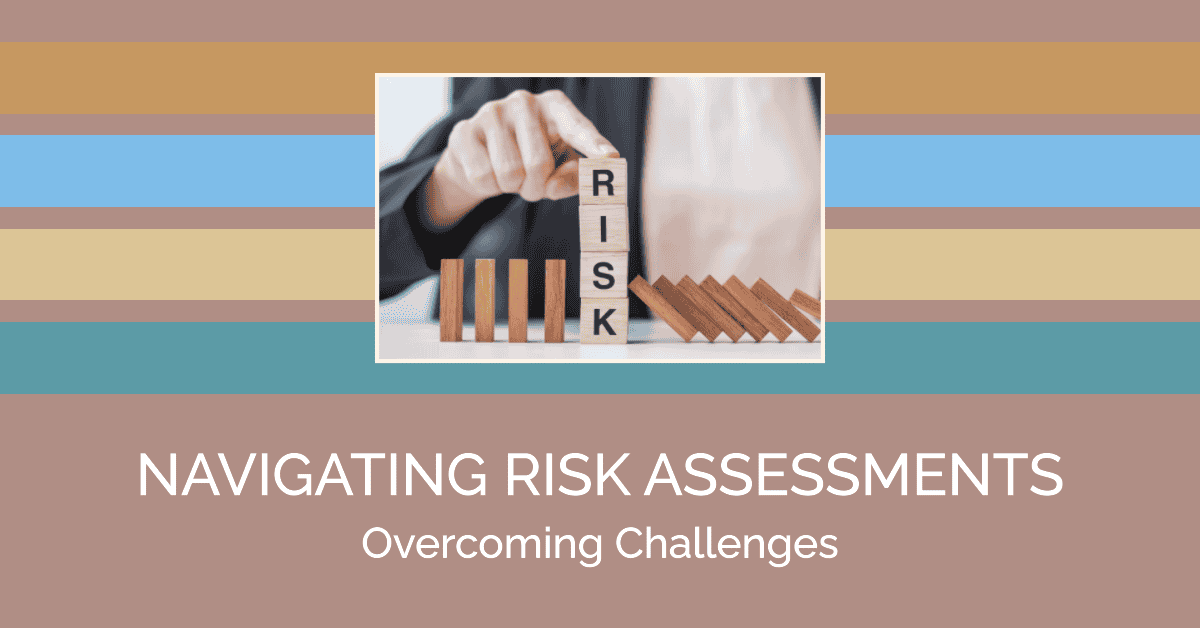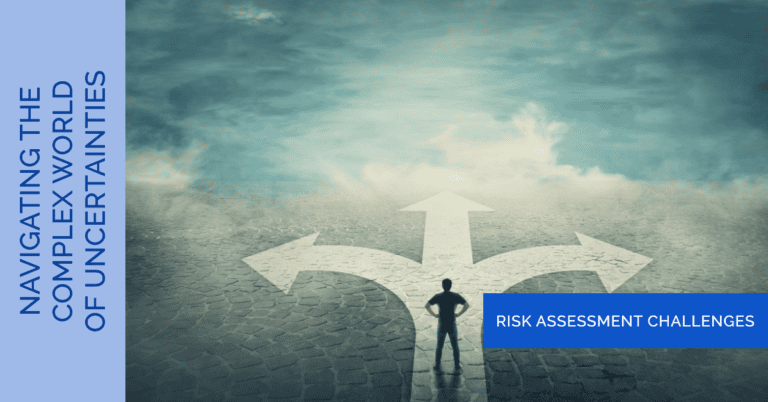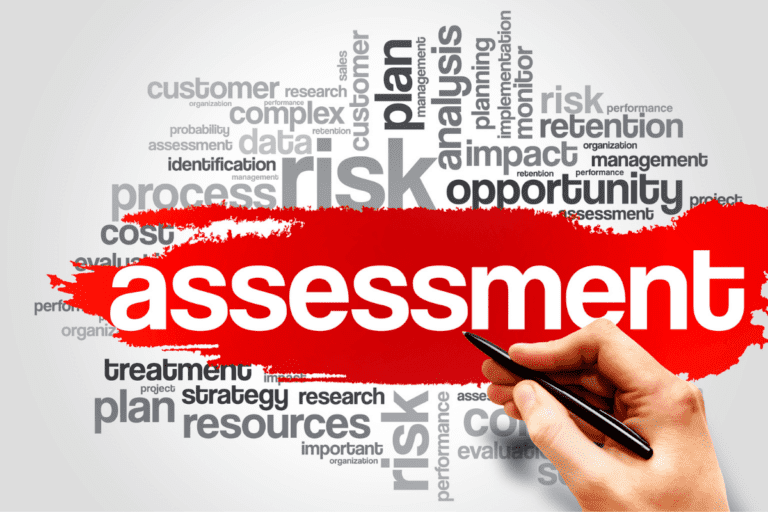If you’ve ever been involved in a risk assessment, you might have experienced working through challenges that made the process painful, exhausting and even frustrating. This isn’t me venting—it’s a fact: risk assessments are riddled with challenges, more than we are sometimes aware of.
You might argue: “What is the issue with that? Risk assessments ensure an organisation is properly equipped to deal with risks!” And that would be well said. However, the consequences of dealing with these challenges start with your risk assessment outcomes.
This article discusses the challenges of risk assessments, why they matter, and how to overcome them to create an effective risk management process.
What is a Risk Assessment?
Before exploring the problems, let’s briefly remind ourselves what a risk assessment involves.
So, what is a risk assessment?
In short, it means an ordered and iterative process where we attempt to identify, analyse and prioritise the various threats, opportunities, concerns and vulnerabilities that could impact an organisation.
Designing an appropriate risk assessment enables organisations to make informed decisions by considering how to manage the potential impact of risk through control, mitigation, and contingency strategies or by simply being aware of the level of risk involved.
Why are Risk Assessments Important?
Because they are a fundamental part of a good risk management strategy, risk assessments help us know what could go wrong early on—knowing what can go wrong early on means that organisations can take steps to prevent it or limit the potential damages if it does.
What are the Core Risk Assessment Challenges
Here’s the thing: there are many challenges with determining risk. These include:
Data Quality and Availability
A key challenge in risk assessment is data quality and availability. Whenever we analyse risks, we should use data. Good risk analysis depends on good data. In situations where data are unavailable, accurate risk analysis is not possible. Often, data do not exist, are outdated, or are otherwise inadequate.
For example, in environmental risk assessment work, not having current environmental data can result in incorrect risk assessment, and in cyber risk management, not having access to the most recent threat intelligence can put organisations at risk from emerging threats.
The Complexity of Risk
These might be incredibly multifactorial, interdependent risks. For instance, many risk factors are at the operational risk level—human error, system breakdown, outside threats, etc. A numerical assessment of each risk factor in isolation, from a single perspective, runs the risk of getting things wrong.
Subjectivity in Risk Evaluation
Many risk assessments involve a degree of subjectivity, particularly when assessing the probable size of a possible loss. Different risk managers could come to different conclusions regarding the size of a particular risk. This problem can be exacerbated when performing a scenario analysis or assessing a new type of risk with no extended history (data).
Regulatory Requirements
Regulatory requirements for risk assessments are another substantial obstacle: there are often different regulatory regimes for different professions, industries and geographies, and they also change frequently.
Risk managers may find it challenging to track these changes in the regulatory landscape and align their firm’s risk assessment methodologies with current regulatory requirements.
Vulnerability to Emerging Risks
Both uncertainty and variability might make emerging risks, such as those posed by new technologies and changing market conditions, difficult to anticipate and for risk assessment methods to capture.
Additionally, technological change, such as rapid advances in AI, can lead to new risks that risk assessment methodologies may not be designed to tackle. Greater vulnerability to emerging risks then translates into increased risk.
Balancing Threats and Opportunities
A further challenge can be balancing threat exposure with access to potential gains, as minimising risk threats might also limit growth opportunities. Sometimes, balancing associated and co-benefits is challenging, especially if potential rewards require taking more negative risks.
Communicating Risk Assessment Findings
Even after the evaluation, the difficulties of communicating the results are not over: translating the identified risk profile into terms that decision-makers can understand is challenging.
Risk managers must communicate information about the risks’ implications on each other so that decision-makers can make rational choices that minimise uncertainty, ineffective resource use, and risk exposure.
Navigating Through the Challenges
These obstacles don’t mean that we can’t make a suitable risk assessment. Here’s how you can sail through some of the most common issues.
Enhancing Data Quality
Organisations can also develop strong data collection and management systems to tackle the data quality problem. For instance, they can increase the capabilities of their data by using advanced analytics, artificial intelligence and machine learning.
Obtaining timely, comprehensive, and relevant data via a collection system with continuous monitoring capabilities will prove invaluable in a risk strategy.

Using a Risk Matrix
If correctly populated with qualitative metrics, a risk matrix helps control and mitigate the potential confusion of granular risk factors by grouping the raw data according to the probability of an event and the resultant potential consequential impact. Doing so allows a risk manager to identify those risks that, if given the endorsement of senior management, remove uncertainty that a given risk warrants attention.
Standardising Risk Evaluation
Standardising risk assessment methodologies can address subjectivity in risk evaluation. This can be achieved by providing predefined risk assessment criteria for probability and Impact.
Staying Compliant with Regulatory Requirements
Due to the changing nature of regulatory requirements, risk managers should periodically review and update their risk assessment practices. They might work closely with legal teams or use software that assesses risks and monitors regulatory compliance. For example, automated regulatory compliance software can help identify regulatory requirements for all risk assessment methods used in an organisation.
Regular audits can also help to identify areas where the organisation might not be able to comply with regulatory requirements.
Focusing on Resilience
Because of the ambiguity surrounding emerging risks, resilience planning is an indispensable part of risk management.
Resilience allows an organisation to manage risk and recover speedily and effectively after a breach or other potential threat. A well-thought-out risk management plan that includes resilience planning can help an organisation withstand the blow of emerging risks.
Conducting Scenario Analysis
Scenario analysis, for example, may be instrumental in balancing risk and opportunity. Through ‘what-if’ planning, i.e., if X, then Y, an organisation might have ‘unlearned’ that pursuing new opportunities often means assuming more significant risk.
Improving Communication
Risk managers would be wise to clarify the presentation of findings in risk assessments. This could mean developing brief reports that convey salient information, such as the main risk, impacts and control measures, using visual aids like charts, graphs or the aforementioned risk matrix if appropriate.
Emerging Trends and Future Challenges
Just as the risk world will change, so will the challenges around risk assessments. Among these emerging trends, cyber risk, which leaves organisations increasingly exposed to threats of new and sophisticated digital dimensions, would perhaps deserve particular attention: the need to respond to regulatory requirements related to the use of AI would also require rethinking assessment approaches and introducing new hazards.
Another trend is a growing attention to environmental risk and sustainability. Rising awareness of climate change and other environmental risks will require more risk managers to consider these factors when assessing risk. This might involve paying more attention to long-term risk responses and understanding the impacts of environmental change on their businesses.
Final Thoughts
Assessing risk is an essential part of a risk management plan. However, risk assessments of organisations and individuals are often bogged down by various challenges, such as the quality of the data used in the assessments and variations in risk factors and actors. Understanding these challenges and how to approach them enables organisations to be better prepared for what the future holds in terms of threats that can impact them.
Similarly, with the risk landscape changing less predictably, risk assessment approaches, methodologies and practices must also evolve. Informed, proactive and dynamic use of effective risk assessment approaches can help organisations endure and flourish in the face of adversity – right from the beginning and for many years to come. Risk assessment is not about defining the risks. It’s about recognising, communicating and managing the risks in a way that supports the organisation’s missions and objectives.
There will always be some difficulties in risk assessments, but these will be most successfully addressed by appropriate strategies that ensure the risk management function remains embedded within the organisation and is fit for purpose and fit for the future, whatever the risks. This means investing in data quality, establishing ways of standardising how you evaluate what comes in, and working with the headwinds of change produced by new risk events.


